Archive for ‘Office Supplies’ Category
Divide and Conquer: Improve Productivity With Privacy Screens

One of the most popular photos ever posted to the Paper Doll blog has been the Privacy Pop Bed Tent. Whether for a shared dorm room, children’s room, or any situation where you might want a little privacy – for sleeping, reading, meditating, or focus – a bed like this lets you place a divider between yourself and the world.

Organizing your space for privacy can yield much greater productivity.
A room or personal space divider can have the following advantages:
- Delineate a purpose for a space, motivating a stronger sense of purpose.
- Eliminate visual distractions for the user so you can maintain focus longer.
- Eliminate visual distractions for the audience during online classes, video chats, or during webinar presentations. (While virtual backgrounds can be useful, many computers are too old to run this digital solution.)
- Eliminate auditory distractions for the user.
- Dampen sounds for podcasts and audio/video production (if your dividers provide help with acoustics).
- Provide a sense of privacy from prying eyes. (If you aren’t worried about who is watching watching you, you can stay focused on your work.)
- Create a sense of ownership of one’s own space.
- Create a healthy barrier between oneself and others, particularly during flu season (and, obviously, as we are recovering from a global pandemic).
Recently, I’ve had a number of conversations with clients who are looking for better solutions for dividing their spaces.
Some have been working the better part of the pandemic from home with little to divide their own work space from that of their spouses or to divide grownup workspace from remote schooling space or play space from living space.
Others have been been struggling with a year-long, “Maaaahhhhhhhhm, she’s touching me!” lack of personal space among their kids.
Further, others are approaching a return to working in their offices and are dreading being distracted by their colleagues, anticipating having their focus, concentration, and privacy being threatened after a year of (somewhat) controlling the sensory inputs during work time.
And some are just freaked out about breathing around other people in an open workspace that, even during the best of times, ensured that they all got one another’s cold and flu germs.
Wouldn't you like to create your own private, dedicated workspace wherever you are? Share on XWouldn’t you like to create your own private, dedicated workspace wherever you are? Today, we’re going to look at a variety of options that can help you at home and work to give you more focus, a greater sense of privacy and a little more division between you and everyone else.
SET UP PERSONAL WORKSPACE DIVIDERS
The Poppin Dark Gray Portable Space Divider suits multiple circumstances where you might want a little privacy to accomplish your work:
- At desks or tables shared by multiple students (whether at home or at school)
- At a desk or table in your public or university library
- At a table in a coffee house or co-working venue
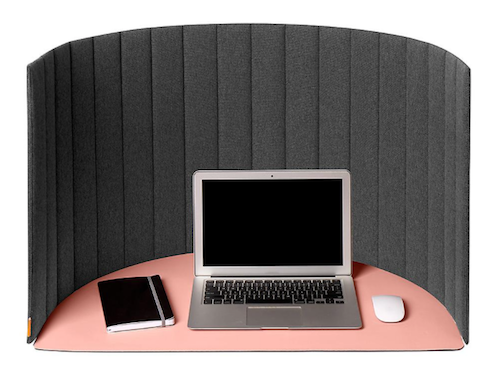
This sturdy 54″ wide by 20″ high divider unrolls and sets up to serve as a self-standing structure and says (politely), “This is my work area. All others, keep out! This means you!” letting you study, read, or work with efficiency and without distractions.
The Poppin Portable Space Divider is made of medium density fiberboard (MDF) and fabric. (MDF is an engineered wood product, manufactured by breaking down residual hardwood or softwood byproducts and turning them into wood fibres, mixing the fibers with wax and a resin to keep it bound. Then, by applying high temperature and pressure, MDF is turned into panels, which are generally more dense than plywood, so they’ll stand up sturdily.) Each of the 18 MDF panels is inserted as a slat in the dark grey fabric.
The divider is lightweight and and portable; just roll it up like a yoga mat, fasten the hook and loop closure, and carry it over your shoulder with the nylon carrying straps. No downward-facing dog required.
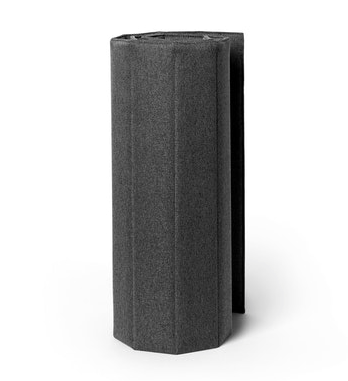 The Poppin Portable Space Divider is available for $59.99 at The Container Store
The Poppin Portable Space Divider is available for $59.99 at The Container Store. (Poppin has also created Curved Desk Pads
in grey, slate blue, and blush to partner with the Portable Space Dividers. They are also available from The Container Store, for $19.99.)
If you own (or work in) an open office, you might be looking for something a little more upscale to give returning employees something to help them maintain focus. eScape Desk Screens come in a wide variety of colors (including Sky Blue, Green, Emerald Green, Orange-Yellow, Orange, Red, Purple-Red, Purple, Blue, Dark Blue, and for some versions, Silver Grey, White, and Sesame Black) and mounting styles.
The eSCAPE Edge Clamp with Knob Acoustical Desk Divider 12″ high version is made of colorful, 12 mm-thick, round-edged, acoustic tiles made from recycled plastic (PET) bottles. Five width options are available (23″, 35″, 47″, 59″ and 71″) and they are attached to desk surfaces with a knobbed clamps (two for the three smaller sizes, and three clamps for the two larger versions):
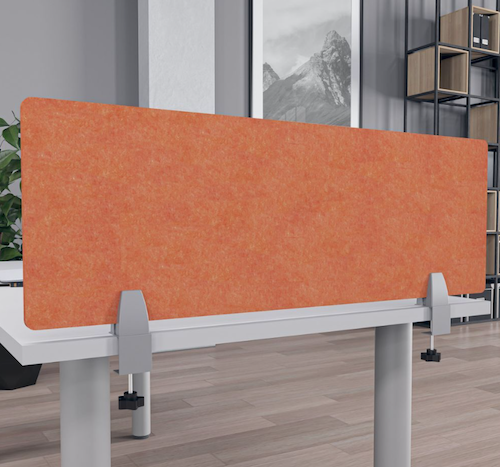
The 16″ high (shown below) and 24″ high versions offers the same colors, features, and options, but more privacy:
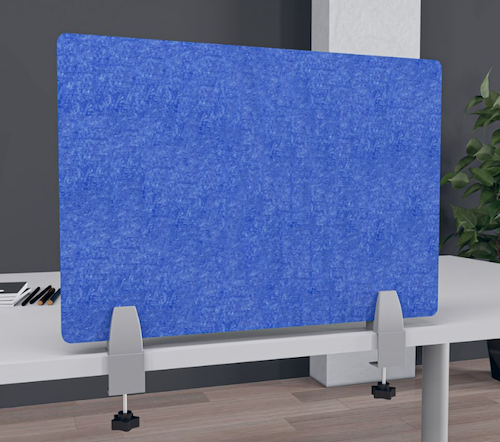 The clamped versions are sold by Skutchi for $133.39.
The clamped versions are sold by Skutchi for $133.39.
If you’d prefer a free-standing version of the eScape Desk Dividers, Skutchi also sells those.
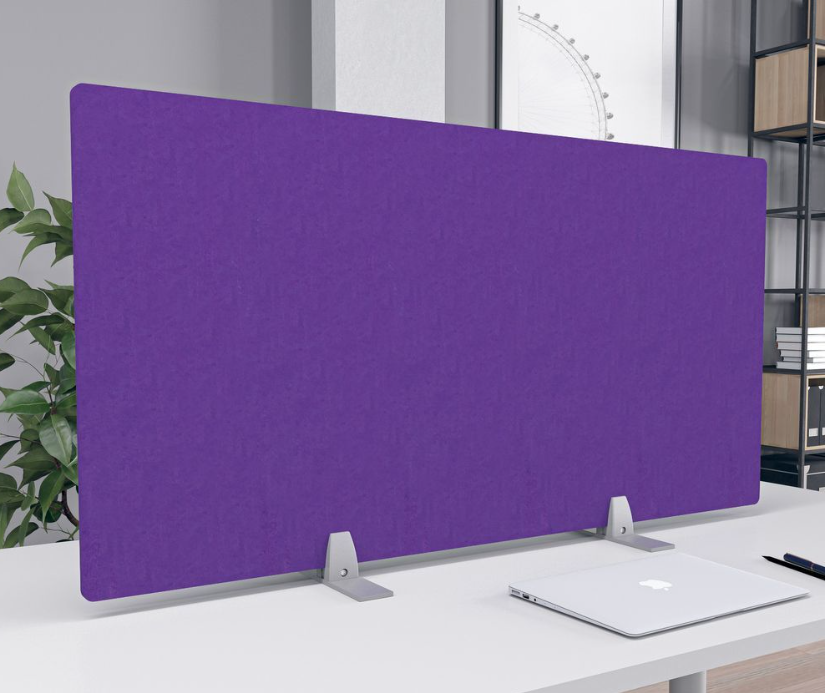
You’ll lose a quite a bit of desktop real estate to make room for the mounts, but you’ll save a bit of money, as the 12″, 18″, and 24″ high options (all with the same width, color, and feature options of the clamped versions) sell for $96.59.
Skutchi’s dividers are custom-made and available with free shipping.
Given everything that’s happened over the past year, you may be considering getting some kind of sneeze-guard to surround your work area or classroom space (for yourself, your children, or for the school in which you teach). These come at a wide variety of price points and aesthetic levels, from Applied Ergonomics’ fold-flat, polycarbonate school hygiene barriers, $299 a ten-pack:
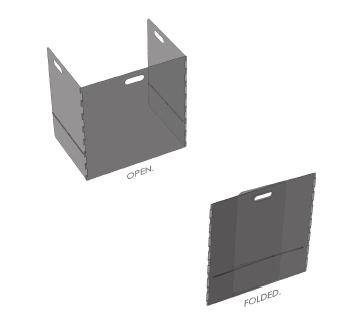
to Mergework’s Terrace and Enclave Sneeze Guard Workspace Social Distancing solutions with multiple mounting options at fancy-pants pricing.
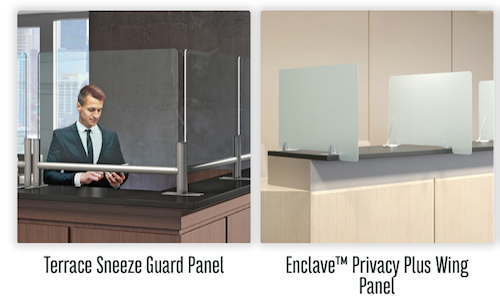
If you’ve ever worked in an office with cubicles, you know that the absence of a door can have impact on privacy. (To be honest, so does the absence of a ceiling, but unless you move that Privacy Pop Bed Tent into your cube, I’ve got nothing for you.) If you’ll be returning cube setup, your HR department might be interested in this rolling Quartet Workstation Privacy Screen to improve productivity (and morale).
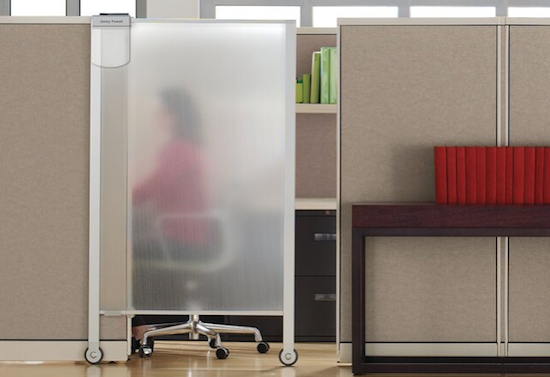
The translucent, shatterproof privacy screen measures 38″ wide by 64″ high. The frame is aluminum, while the screen itself is polycarbonate, making the unit durable and lightweight. As-is, the screen can roll into place for cublicles up to 65″ tall, and there are leg extenders included for cubicles taller than 68″.
There’s even an attached whiteboard with a nameplate so you can tell colleagues when you’ll be available and let them leave messages for you.

The Quartet Workstation Privacy Screen is available from Staples, Quill, Granger, Amazon, and Walmart. Currently, the price ranges significantly, from $261 to $390, and is the least costly at Walmart and Amazon. (There is also a sliding, non-wheeled version, measuring 36″ wide by 48″ high, which slides into cubicle walls and is not wheeled; it runs about $205.)
USE ROOM DIVIDERS TO CREATE WORK ZONES
Sometimes, you need a divider of greater size and scope. Over the years, I enjoyed being interviewed online, like the eight shows I did for Smead‘s Keeping You Organized video podcast:
Secrets to Organizing a Small Business
Fears That Keep You From Getting Organized
Paper vs. Digital Organizing (Part 1)
Paper vs. Digital Organizing (Part 2)
How to Get Organized When You Have an Extended or Chronic Illness (Part 1)
How to Get Organized When You Have an Extended or Chronic Illness (Part 2)
Essential Lists for Organized Travel (Part 1)
Essential Lists for Organized Travel (Part 2)
The problem? Behind my office is another room that is not appropriate as a professional video backdrop. Until 2019, as a stop-gap measure, whenever I made these kind of videos, I’d turn my desktop computer toward the opposite wall and move my chair; however, the overhead lighting against this background made spidery shadows above and around my head. I felt like a true Not-Ready-For-Prime-Time Player.
About eighteen months ago, when participating in Ray Sidney-Smith’s Productivity Summit 2019, I needed a better solution. My plan was to try to get a pretty room divider, something along the lines of the gorgeous Japanese shoji screens one often sees in movies — light wood, rice paper, hinged panels. Something like this, from Wayfair:
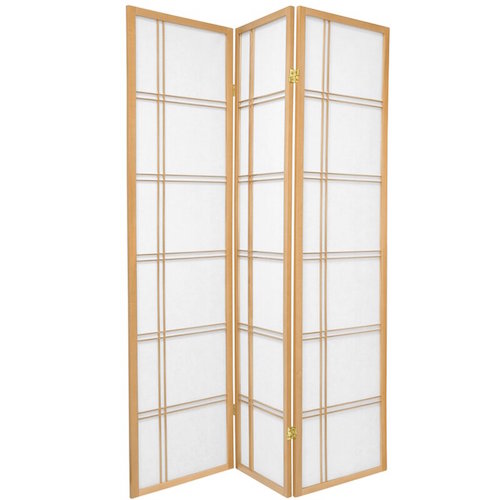
However, I was hoping for something a little less expensive than the (reasonable) $169 that this one goes for, and one available on a little speedier delivery schedule. Unable to find an appropriate screen locally, and with only a few days to go until the summit, my colleague Maria White suggested that I try Ollie’s, a factory close-out store.
There, for a decidedly more pleasing $38, I got a rattan, indoor-outdoor, hinged divider that, on video, looks far more elegant than it does up-close. If you have seen me on any recent webinars or video podcasts, you’ve seen it (and more importantly, you haven’t seen the room behind my office).
For a taste, you can peek at two recent Anything But Idle episodes I did with hosts Ray Sidney-Smith and Augusto Pinaud, focused on women experts on productivity, organizing, and technology. There’s March 8th’s where I was a solo guest panelist, as well as March 15th’s (below), where I shared the spotlight with the always-glorious, brilliant, and charming Deb Lee:
(If you make it all the way through, see if you can find where I almost devolve into a fit of giggles.)
For what it’s worth, if you do want any of a variety of hinged screens, upscale or downscale, two good shopping options are these at Wayfair and the sumptuous designs at RoomDividers.com, including their shoji screens, art prints, office partitions, and other room dividers, like this 6-foot double-sided, Lavendar Road canvas print for $149:

In researching this post, I occasionally found intriguing room dividers that do double-duty. For example, this RHF 5 1/2-foot tall, four-panel privacy screen at Amazon doubles as a corkboard message board and costs only $119.99.

It’s not necessary to purchase special furniture simply to divide a room to provide more focus on each space’s individual purpose.
For example, if you already have a free-standing bookshelf, around five-feet tall or higher, like the Ikea Kallax shelves, you can easily divide a room into sections merely by placing the bookshelf between your two spaces, making a sleeping area and study space, or office and workout area. Check out Apartment Therapy’s The Best Bookcase Room Dividers to get some inspiration.
CONSIDER SPECIALITY DIVIDERS FOR YOUR SPECIAL NEEDS
Of course, sometimes, you will want specialized furniture.
Imagine you’re building a career as a podcaster but you’re a renter and can’t affix acoustic tiles to the wall to create an audio studio. And let’s say you don’t have a walk-in closet loaded with a wardrobe of clothes to muffle the sound. You might opt for the Versare Versipanel Flexible Sound Control Partition Wall, sold by Walmart for $819.

The Versipanel is designed to be an attractive, sound-absorbent, wall enhancement. It’s 8 feet wide by 6 1/2 feet high, comes in blue, black, and grey, and is one single fabric panel with flexible segments.
Rather than being positioned straight-up, like most room dividers, the panel is meant to be positioned with some curve in it in order to stand up & be stable on its own. (For a larger divider, multiple units can be connected end-to-end with the pre-installed heavy-duty magnets.)
Store the Versipanel flat against the wall, or (like a VERY LARGE yoga mat), it can be rolled up and carried away to storage.
If you offer specialized teaching services for tiny humans, whether at a child care center, private school, or tutoring service, you might have a reason to invest in a more serious set-up. Discount School Supply has a wide variety of room dividers, from their Big Screen Right Angle Panels (for $185):
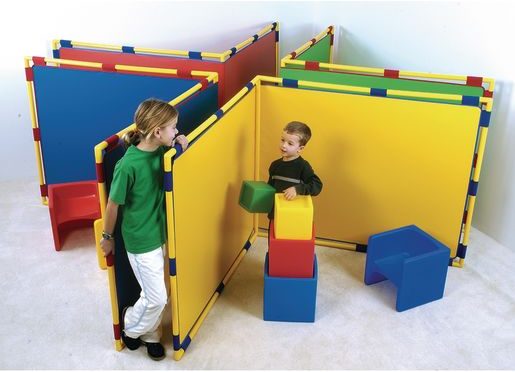
to their line of Big Screen Right Angle Panels mini-classrooms (sure to muffle sounds and improve focus) for $586.87.

FIND YOUR IDEAL DIVIDER
This post is just a sample of your options for organizing by dividing your space, creating zones, giving you privacy, and eliminating distractions. It’s meant to give you a taste of the possibilities available rather than a complete resource. Depending on your physical needs, budget, and the size of your space, you may want to use the following search terms to locate the right dividers for you:
- Room Dividers
- Privacy Panels
- Modesty Panels
- Hygiene Barriers
- Anti-Microbial Barriers
- Acoustic Dividers
THE ULTIMATE IN PRIVACY
If none of these ideas provide you with the level of privacy you need, especially in the workplace, there is one option short of sealing yourself up at home and pretending you’re still on lockdown, though it may be difficult to get your company onboard with the costs.
Poppin has a line of office “phone booths” that gives you a safe, quiet office within your office. The PoppinPod Om Sit and PoppinPod Om Stand, both for $5499, are made of high-grade glass and steel, and give you the privacy to focus, make confidential telephone calls, and isolate yourself from that office mate who does that thing. (You know what it is. Let’s not spell it out.)

Both of the PoppinPod Om versions come in black or white, have USB chargers and a motion-activated light and fan, and feature dark grey, sound-absorbing PET lining. They’re shipped and delivered fully-assembled, because apparently the Poppin people have seen us trying to assemble Ikea furniture and don’t want to embarrass us.
For fancier workspaces, or if you’re hoping to have a work partner with you but still divide yourselves from your colleagues, the PoppinPod Kolo series upgrades from the Om experience and can accommodate 2, 4, or 6 individuals at prices ranging from $7000-$30,000.
And let’s face it, this is as close to Doctor Who‘s TARDIS as we’re ever going to get.
Paper Doll Models the Spring 2021 Organizing Products

It’s finally springtime, the perfect time for new organizing supplies!
For most of the fourteen years I’ve been writing this Paper Doll blog, I’ve delighted in sharing new organizing products displayed at the annual NAPO Conference & Expo. Unfortunately, last year, the conference was canceled due to COVID. This year, although we’re very excited that we will get to have a 2021 NAPO Conference (albeit virtually) next month, there will not be an expo.
However, that doesn’t mean you’ll miss out on new organizing products! I’ve been collecting tidbits and emails over recent months, enough to assure you that there are novel and interesting organizing products out there in the world, and today, we’ll look at a few of them.
Organize Your Papers & Information
Whether you feel like you’re working from home or living at the office, whether “work” is your career or your volunteer gig or having a serious meeting at your kids’ school, the business of your life involves a lot of moving parts. Let’s look at what make these efforts run more smoothly.
Smead Soft Touch Cloth Expanding Files
Right now, most people’s “meetings” are held virtually, with each person in his or her own Brady Bunch-style box on Zoom or the equivalent. As long as we’re dressed from the waist up and have combed our hair, we pass muster. Nobody can see much below our shoulders, so if we’ve scribbled our notes on a Snoopy memo pad, our co-workers won’t be able to tell.
But imagine someday soon, it will be like the “before times” – eventually, we’ll all be back in the “real” world, with in-person meetings. And for good or ill, style will matter, at least a little, and we won’t be able to just carry an armload of papers as we might do now, from couch to desk. Somehow, I suspect our old briefcases will seem stodgy, a remnant of another era, but backpacks will feel just a little too casual for a meeting with the CEO. Smead has found a middle path.
The Perfect Unfolding As We Work From Home
 Readers, I beg your indulgence as I wax philosophical today about folding and unfolding as we work from home. (No, this isn’t about laundry. I’ve written about that before, in 5 “Real Simple” Reasons We Don’t Get the Laundry (or Paperwork) Done.)
Readers, I beg your indulgence as I wax philosophical today about folding and unfolding as we work from home. (No, this isn’t about laundry. I’ve written about that before, in 5 “Real Simple” Reasons We Don’t Get the Laundry (or Paperwork) Done.)
This weekend was my birthday. Last year, I went out to dinner with a friend, and I remember that strange week, as everything was changing, but nobody knew what was to come. We tensely folded ourselves in toward the booth, away from our fellow diners. We were already being more circumspect, but it wasn’t until the next day or so before the reality of 2020 set in. (But this post isn’t really about that, either.)
The Folding and the Unfolding of the Lost Year
Over the past year, I’ve been thinking deeply about folding and unfolding as it relates to our lives now, both at home and at work. In most ways, our lives constricted 12 months ago. We were running around, blissfully living our lives, commuting to work, dining in restaurants, out there in the world. And then, almost overnight, we folded ourselves up, kit-and-caboodle, and took ourselves home. Crumpled into tinier lives in smaller spaces (at least smaller than the whole world we had at our disposal before), anxiety squished us into smaller versions of ourselves.
We’d packed up our work bags, our school bags, our schedules, and folded ourselves away in our houses, nervously watching newscasts and doomscrolling our devices as we perched on the edges of our couches and dining tables.
And then something interesting happened, though we couldn’t see it at first. We unfolded ourselves. We embraced freedom from sitting in one stuffy workspace, at one desk, between the same two co-workers. We unfolded the squished toes that had been crammed into the shoes we wore as part of our uniform to be taken seriously at work. We unpacked our projects and spread them out in the new spaces we had to create to work at home while avoiding feeling like we were living at work. (More on that in a bit.)
The Unfolding of New Opportunities
As some parts of our lives fell by the wayside, other new adventures eventually appeared.
I am proud to announce that I recently became Meori‘s first guest blogger. You might recall that I first wrote about Meori three years ago, in NAPO2018: Paper Doll Explores Meori & the Glorious Goodies Within.
When I was first contacted about being a guest blogger, I was enthusiastic but cautious, as I always am in these situations. As a Certified Professional Organizer®, I’ve built my practice on developing strategies to guide clients in creating systems for making their lives more organized and productive. I view organizing products as tools, always worthy of consideration, and I tell clients (and you readers) about how those tools can serve their needs. (And yes, I tell you about my favorite products.)
But I’m not a salesperson, and if they’d wanted someone to be a product spokesperson, I wouldn’t be anyone’s first choice. (I think we can agree that brevity is not the soul of my wit, and “pithy” is not in my wheelhouse.)
So, I was delighted when I first spoke with Deirdre Meyer, co-owner of Meori (with her husband Dirk) and Karen Oboy, Meori’s sales and marketing manager, about this opportunity. Deirdre made it clear that she wanted bloggers who knew about the necessary skills and systems of organizing.
And better yet, she wanted me to write a LONG post. (Readers? Can you imagine how hard it was for me not to jump through the Zoom window and hug them in their Seattle offices?)
In my premiere post, Home Office Storage Ideas: From Dad’s Office to the Modern Home Office, the great people of Meori gave me free reign to cover both the strategies (mindsets and systems) behind creating a peaceful, productivity-producing home office space and tactics (tools and methods) for making it all work. I encourage you to read the post at Meori’s site and let us know what ideas resonated with you. 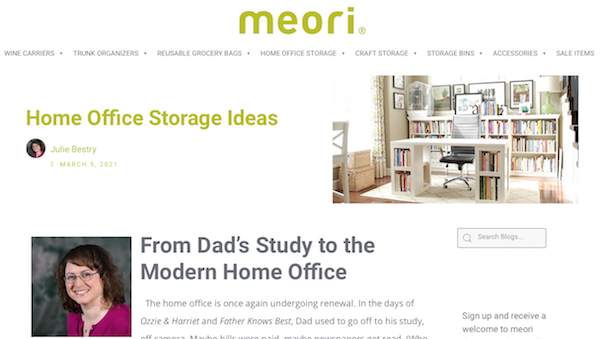
Unfolding and Folding Products
Initially, I was intrigued by Meori’s growing line of fold-flat storage products for home and office, but I was puzzled by their name, as I’d seen that the labels on the packaging were in English and German, and Meori didn’t strike me as a German word. It turns out, they combined two Japanese words, “meian” for great idea and “origami,” to create meori as “the fantastic idea of folding.”
I got excited, because I like things that fold and unfold, or collapse and recreate themselves. I’ve written before about how much I love Origami Rack shelves, desks, and racks, which “unfold” much like one opens an accordion or an ironing board. From flat-pack to fully useful in a minute!
Long before the pandemic, I was singing the praises of my Origami 6-Tier bookshelf, shown in operation above.
(I’m not an affiliate for either Meori or Origami Rack, but it occurs to me that, like Reese’s Peanut Butter Cups, these would be two great tastes that taste great together!)
Time To Unfold Again
We all eventually found our temporary footing, dealing with each ad hoc bump in the road that was 2020-2021. But lately, as the one-year mark approached, I’ve heard more complaints. Sitting on Zoom calls, I’ve noticed more and more people looking tense, almost as though they’d folded themselves directly into those tiny Zoom boxes. People are rolling their shoulders, trying to get rid of cricks in their necks. They’re fidgeting. They’re hitting the pandemic wall. They’re experiencing burnout.
Does that sound like someone you know (or someone you became) in the past year? It wouldn’t be surprising if it did, because a study by the CDC’s National Center for Health Statistics shows that 41% of Americans were showing signs of clinical depression or anxiety disorders at the start of this calendar year, up from 34% last spring. As I’ve written many times in the past year, we need to give ourselves some grace.
There have been multiple articles about hitting the pandemic wall:
It’s Not Just You: A Lot of Us Are Hitting the Pandemic Wall (Huffington Post)
Why Kids Are Hitting the Pandemic Wall (CNN)
America Has Hit the Pandemic Wall (The Washington Post)
This article from Mayo Clinic, Job Burnout: How to Spot it and Take Action, was created in the “before times” but it’s just as apt now. They define burnout as, “…a special type of work-related stress — a state of physical or emotional exhaustion that also involves a sense of reduced accomplishment and loss of personal identity.” Those symptoms sure sound familiar to my friends and clients.
Personally, after hitting a snag back in April, 2020, I felt like I was handling everything fairly well. After all, I’d been “working from home” (for administrivia) for most of twenty years, though it only make sense to organize at clients’ homes and offices, because that’s where the clutter lives!
“You are not working from home; you are at your home during a crisis trying to work.” pic.twitter.com/nsfb2ecTZZ
— Ethics in Bricks (@EthicsInBricks) January 2, 2021
But, as wise tweets reminded us, we weren’t just working from home. We were working from home during a crisis. I thought I’d handled the complexities of virtual organizing and “working from home” well until January, and then all bets were off. Focusing got harder; I blew through a soft deadline and had to explain to the nice Meori people that yes, I’d hit the pandemic wall, too.
Unfolding & Untangling Your Work Self and Your Self Self
It’s been my contention for a while that the biggest problem we experienced, just after we got a hang of working from home, is that we made our work lives so comfortable that we were now living at work.
One good thing about our old lives was that, for most people (who weren’t already working from home), it was easy to fold oneself up to fit in a work space and a home space. Before the pandemic, people who went off to work didn’t need the same kind of help as work-from-homers, such as I’d presented in R-E-S-P-E-C-T: The Organizing Secret for Working at Home back in 2015.
That post focused on how to show respect to yourself, and how to get others to respect the value of your time, when you’re working from home. Nowadays, that advice is more needed that ever.
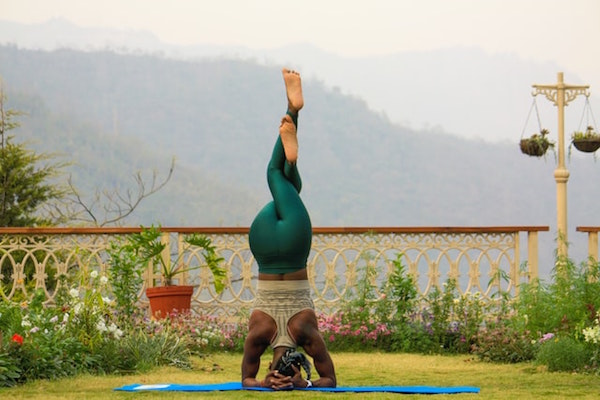
Photo by rishikesh yogpeeth on Unsplash
If you’re feeling all-folded-up, maybe even tangled up, I encourage you to start with the following:
1) Separate your work space from your home space.
I know, that sounds ridiculous. You probably don’t have oodles of space You finally found the “good” lighting so you don’t mind having your Zoom camera turned on, so I’m not going to tell you to create two spaces, one for Zooming for work and one for Zoom-hanging with your friends. (But if you do have the space, your friends will love you just as much if you move the laptop or tablet to the couch, and look more like if they were on the couch with you, in an imperfectly-lit room, and less like you’re about to advance a Powerpoint slide at any moment.)
Basically, it’s been a year, and you’ve probably got a work space that works for you. (If not, that’s even more reason to check out my Meori guest post!) But maybe it’s time to create more space at home in which to live.
As the weather warms up, maybe move a chair onto your front porch and read 10 pages of a novel in the fresh air and daylight during your lunch break? Maybe make sure you’re not eating at your desk, even if your desk is your dining table?
2) Understand that downtime is good for you – and your career.
Usually, my advice is designed to make your work life more productive. For years, in the “before times,” I told clients to treat working from home as if they were working from an office. Run laundry or make personal calls at lunchtime, if you must, I’d say, but work when you are “at work” and do home things on your “personal” time.
Wow, how very 2019 of me!
This advice made sense when the struggle was ignoring inanimate sensory inputs (a pile of laundry, bills to be paid, dinner to defrost); now, the sensory inputs are tiny humans needing help, or a gentle prodding, with online school. You can’t, and shouldn’t, be all-work-and-no-play during the day.
According to research by the National Bureau of Economic Research, Zooming is helping us keep our meetings shorter, but we’re working longer. “We also find significant and durable increases in length of the average workday (+8.2 percent, or +48.5 minutes), along with short-term increases in email activity,” they found.
As the articles on hitting the pandemic wall acknowledge, we’re all experiencing overstimulation. We’re ALWAYS ON, so of course it’s hard to wind down. Just as the temptation to address home things during work hours must be guarded against, we struggle with doing more work during “home” time.
So, maybe don’t check work email while you wait for the pasta to boil. Pick up a book from your to-be-read pile instead of a report from work. Turn off your Slack notifications at night and on the weekend.
Embrace the idea that you are more than just your job. Perhaps read this New York Times article, Remember: What You Do Is Not Who You Are. A snippet I particularly liked, in (and following) an interview with Art Markman, a professor of psychology and marketing at the University of Texas at Austin, said:
“The brain needs a little downtime,” he said. “You can’t sustain concentration. Unless you can get away from the problems you’re trying to solve in your work life, you don’t give your brain a chance to reset and come up with a different way of characterizing what you’re dealing with. So even if your primary goal in life is to be as productive as possible at work, you need some time away to make that happen.”
This doesn’t mean you shouldn’t be invested in your work or not care about your career and the people you work with. That investment can be an asset, and being passionate about one’s work can help lead to better output. Rather, give that investment a ceiling.
3) Put the commute back into your day.
Inc. Magazine recently ran an article called The German Secret to Getting More Done While Working Remotely. Even though my job is to help people be more productive, inwardly, I groaned when I read the headline. Isn’t everyone already feeling guilty and dismayed by not getting more done, as if the purpose of life was to be more productive? (Paper Doll has a secret for you. I think the purpose of life is to ENJOY YOUR LIFE. Be productive so you can have more time to do that!)
Paper Doll has a secret for you. I think the purpose of life is to ENJOY YOUR LIFE. Be productive so you can have more time to do THAT! Share on XWhat did you do on your morning commute? Did you listen to a podcast? Talk to the people who sat by you on the train? Read? Maybe your “commute” was just driving your kids to school before turning around and heading home for the rest of your day. Are you missing those things? Your afternoon commute has similarly been blown out of the water.
For years, I’d recommended to clients who had trouble starting their work days to put on their shoes, even their coats, and go outside and then come back in before sitting down to work. Whether they went to a coffee house to procure overpriced coffee, walked around the block, or just went out the garage door and came back in the front door, this helped them trigger their brains that it was time to start the work day. Whether it’s our morning commute or our kids hearing the announcements over the PA at school (they DO still do that, right?), we need rituals to start our days.
Well, this fancy-pants Harvard professor – OK, I’ll be fair, it’s possible he has perfectly quotidian pants – advises much the same, though he focuses on the end of the workday. Per Professor Ashley Willhans, the Germans have a concept called feierabend. Google Translate merely says it’s “the end of the working day,” but apparent it’s more of “a daily evening celebration marking the moment when work is switched off for the day.” (And it apparently involves beer.)
In the old days, people sometimes went from work to the gym, and then home. So maybe this means our date with Yoga With Adriene needs to come at the end of our work day, and maybe that needs to be a bit earlier? Perhaps knowing that we can’t push dinner too terribly late (either for the comfort of our family or of our digestion) means that we’ll have to truly stop work so we can change from our work loungewear into our workout loungewear and work out at a decent hour so we can eat at a decent time?
My own end-of-day ritual is calling Paper Mommy. The idea of debriefing, recapping my work day, out loud (often during a 45-minute walk outside) is just what I need to unknot, detangle, and unfold my brain, my body, and my life. What kind of “commute” could you add to the start and end of your day?
Unfolding of Hope and Confidence
In the past year, my friend and colleague, Dr. Melissa Gratias, introduced me to the concept of the Shraddha Sutra she learned in her meditation class. (You can read Melissa’s take on it in her post, Are We Broken?)
śraddhā = śrad + dhāśrad literally means “that which gives you space and holds you in place” dhā provides nourishment for you to grow śraddhā conviction; faith; trust
However, my friend’s meditation teacher explained it more conceptually as “radical trust in the perfect unfolding” of one’s life.
Whoa.
Melissa and I have been discussing this concept a lot over the last year, as we look at how our spaces, our careers, our relationships, and our very lives have been evolving. I said it in my post, The Now Normal: When the New Normal Changes Quickly, and I have been surprised by how prophetic it was. (Whoohoo, Paper Doll!)
This March is not last March. We see sunlight instead of darkness. Every day, more of our parents and grandparents and friends are able to get the vaccine. More of us have a sense of what we want our lives to be (or not be) as we come out on the other side, as we unfold ourselves into new shapes and new selves.
Perhaps this probably didn’t sound very much like an organizing and productivity post. But please remember that the purpose of organizing, at least the Paper Doll version of it, is to have more space and time to do the things you want with the people you care about.
So, I don’t know about the radical trust part, but as we move forward, I hope that you experience the perfect unfolding of your life.
This “Magic” Product Makes Shipping Packages as Easy as Wrapping Leftovers
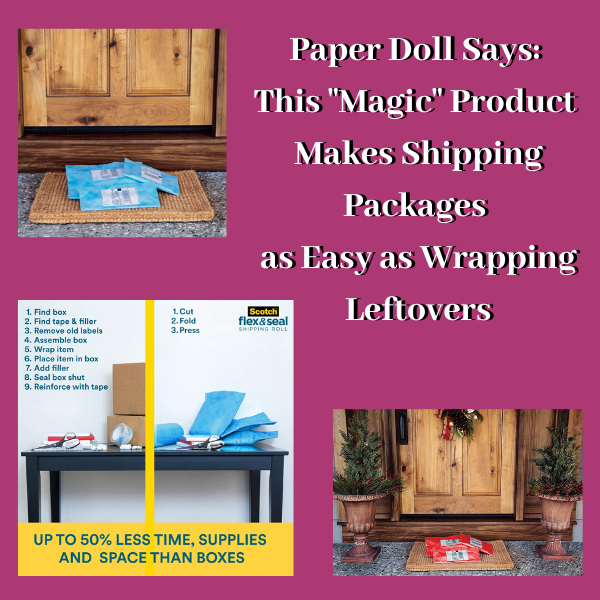 Packing and shipping is not exactly rocket science. And yet Paper Doll hears a lot about shipping-avoidance and packing-box frustration. In a perfect world, whenever we wanted to ship something, we’d have the ideal sized box (so as not to waste space, and also not to have one of those almost-sealed, bulging boxes where the flaps quite don’t meet). We’d also have just the right amount of padding material to prevent jostling, and it would all be easily recyclable.
Packing and shipping is not exactly rocket science. And yet Paper Doll hears a lot about shipping-avoidance and packing-box frustration. In a perfect world, whenever we wanted to ship something, we’d have the ideal sized box (so as not to waste space, and also not to have one of those almost-sealed, bulging boxes where the flaps quite don’t meet). We’d also have just the right amount of padding material to prevent jostling, and it would all be easily recyclable.
My clients tell me they procrastinate on returning purchases and shipping care packages, birthday gifts, and other things because – although they have lots of boxes and bubble mailers thanks to their online shopping habits – nothing is ever the right size. This isn’t just a frustration; it’s also a financial issue.
In 2015, the major players in the ground shipping world, like UPS and FedEx, stopped pricing solely by the pound. They realized that a lot of relatively light packages were being shipped, and that cost them money. So, they started using dimensional weight, which had already been the practice for air-shipped packages.
What is dimensional weight?
The shipper calculates the cubic size of a package by multiplying its length, width, and height. Once the dimensional weight is calculated, they compare it to the actual weight of the package and the larger of the two is used to determine the package’s actual “billable” weight.
Need some help with the math? Google dimensional weight shipping calculators, like this one from ShippingEasy.com.

What does this all mean for you? A small thing in a bigger box will cost you more than that same thing in a smaller box, which means you have to keep even more shipping supplies on hand to find the just-right solution, and that causes clutter.
If only someone had a better idea. Oh, wait. Someone did!
SCOTCH™ FLEX & SEAL SHIPPING ROLL
3M is a marvel of innovation. The same parent company that brought us Post-It® Notes and Command hooks has done it again. They’ve invented a shipping solution that requires keeping less packing material and fewer supplies, takes less time, and creates a smaller dimensional weight for the things you ship.
And, honestly, I’m not persuaded that it isn’t some kind of magic.
Scotch™ Flex & Seal Shipping Roll
First, let’s get an overview of the product, with some fun, bouncy music.
Cool, eh? So, let’s dig deeper. How does this product save space, time, and money?
Eliminate clutter
What do you keep on hand for shipping packages? Boxes, right? Probably lots and lots of Amazon (and other) boxes. Maybe USPS “priority” boxes (which always seem to be way too large or just a little too shallow)? A family member bought a gorgeous Kitchenaid stand mixer and had it shipped. It came in a glossy, specially-carved Kitchenaid box (with a photo of the mixer on the package) inside a matching, plain, cardboard Kitchenaid-branded box (each with specially-placed handles for ergonomic carriage) and the whole thing was inside a box that would have made a nice toddler playhouse.
I bet you don’t just hoard boxes. I bet you have bubble wrap. (And not nice rolls of bubble wrap, but pre-used bubble wrap that someone in your house has popped and flattened along the edges, right?) Or maybe you have styrofoam peanuts. Or those clear, little balloons that look like nothing so much as an inflated zip-lock sandwich bag without the zipper?
And where are you storing these cardboard boxes, bubble mailers, poly bags, bubble wrap, and package stuffing? Probably wherever you can find to put it, and likely not in a very sound system. (No, I’m not peeking in your windows while you’re sleeping. Promise!)
Because the Flex & Seal allows you to customize your package to fit precisely around the edges of your item, there’s no wasted space in the box and no unnecessary padding to keep on-hand. Scotch’s marketing claims to save up to 50% on supplies, time, and space vs. using boxes. I don’t know how they arrived at that statistic, but it does mean that you can take up less space, and the roll can be stored horizontally or vertically, like a rolled-up yoga mat.
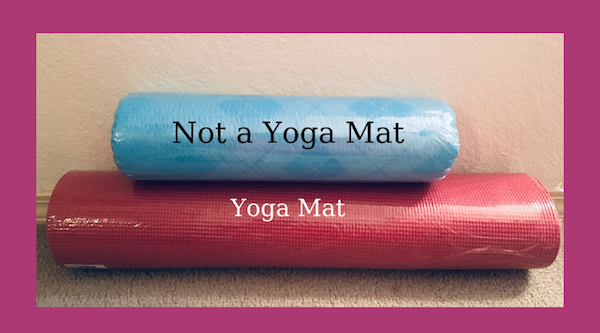
Save time
My clients are invariably piling up to-be-shipped items on the dining room table or on kitchen counters because they anticipate (often correctly) that it will be time-consuming to find a suitably-sized box, pad and pack the item(s) safely, and seal everything confidently. Scotch™ Flex & Seal Shipping Roll promises make packing as simple as:
- Cut a piece of the roll long enough to sandwich the item you’re shipping.
- Fold the Flex & Seal over whatever you’re shipping.
- Press to seal it by continuing to press around the three (non-folded) edges. (Imagine you’re wrapping your Thanksgiving leftovers in aluminum foil before putting them in the freezer. Or, as the product’s web site says, “Make sure you’re pressing gray surface to gray surface. A helpful way to remember it: Do not wrap like a present, fold and press like a calzone!”)
That’s it. Print out your label and affix it to the package. Wheeeee!

Secure and immobilize your package.
Scotch™ Flex & Seal Shipping Roll may look like a prettier version of bubble wrap, but it harbors a secret superpower. Flex & Seal is constructed with three layers.
The blue outer layer is tough and durable, making the package water-resistant and tear-resistant. The clear middle layer is bubble wrap, but seems slightly less inflated (and is difficult to pop), creating firm cushioning for the package.
And the grey inner layer is MAGIC. (OK, I’m sure it’s science, but Paper Doll can’t figure out how it works!) This inner layer’s “adhesive technology” makes it stick securely to itself but not whatever you’re shipping!
Scotch™ Flex & Seal Shipping Roll sticks to itself and not to what you put inside! What kooky shipping witchcraft is this? Share on XOnce you fold the Flex & Seal over your item (sandwiching it), just press firmly for a guaranteed seal. Folded and smushed (for another scientific term), the Flex & Seal conforms to the shape of whatever you’re shipping, immobilizing it to protect against wiggling during shipping.
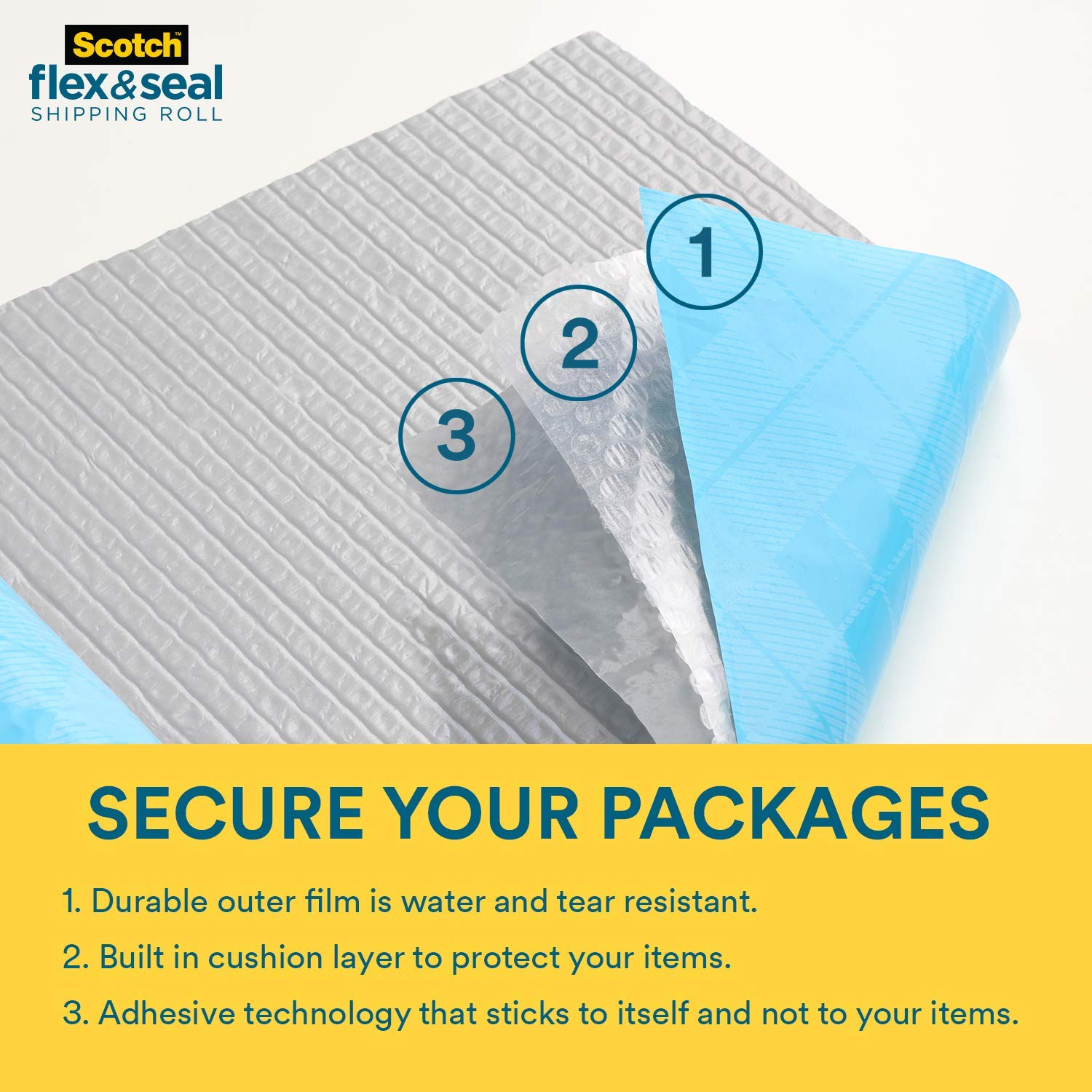
Save money.
The marketing for the Flex & Seal Shipping Roll notes that by eliminating extra packing and shipping supplies, and securely sealing around the shape of whatever you’re shipping, it can reduce the package’s dimensional weight, as we discussed above. That should reduce your costs. Yay!
WHO CAN USE THIS?
Anyone who can comfortably maneuver scissors should be able to use the Flex & Seal. (If you’re doing a LOT of packing, consider a paper cutter in lieu of scissors.) If you – like Paper Doll – sometimes have trouble wrapping presents and fear this might be too similar of an experience, fear not. I’ve been known to unroll too little or too much wrapping paper and then the paper crumples and creases as I try to get just the right amount. Flex & Seal is thicker and sturdier, so that’s not an issue. Also, unlike rolls of wrapping paper, Flex & Seal is only 15″ wide, only a few inches longer than a paper towel roll, so it’s not unwieldy.
So, who can use this?
- People who rarely need to send packages. If you never have boxes or bubble mailers on hand and put off shipping things because you lack room to store them, this makes things pretty easy.
- People who send packages all the time – Grandparents? Check. Crafters who share their creations for fun or profit? Check. Small business owners who ship small, fiddly things? Check. Authors who autograph and ship copies of their books? Check!
When shouldn’t you use Scotch™ Flex & Seal? If you’re shipping something delicate or fragile, stick to a traditional packaging set-up, like a cardboard box with firm but flexible padding and a tight seal. Also, because the inner grey layers must be matched up, it’s not suitable for large packages.
ENVIRONMENTAL ISSUES
Flex & Seal is recyclable. Scotch™ advises just removing the label before dropping the packaging off at a plastic bag recycling location. While not all communities have plastic bag (or plastic film) recycling centers, you can enter your zip code into the search bar at PlasticFilmRecycling.org to find a center near you.

However, I am concerned that not all labels are so easy to peel off. My 10-foot roll of Flex & Seal came to me wrapped in actual Flex & Seal! (How’s that for good advertising? It was very meta.) But both the marketing label (promoting other 3M products) and the UPS label would not peel off cleanly, so I’m not sure if that renders the package un-recycle-able.
HOW TO OPEN FLEX & SEAL PACKAGING
I’ll admit, I was puzzled when my Flex & Seal Shipping Roll (again, wrapped in Flex & Seal) arrived. I saw that I could just cut it open with scissors, but I didn’t want to accidentally cut what was inside. But I also couldn’t just pull on opposite sides of the packaging as if I were opening a bag of potato chips.
In the end, I guessed (correctly), and carefully used the scissors on the corner of the packaging, but I’m betting I wasn’t the only uncertain person, as Scotch™ produced this video to set people straight about three different methods for opening Flex & Seal packaging!
VARIETIES OF FLEX & SEAL SHIPPING ROLL
Scotch™ Flex and Seal Shipping Roll comes in four sizes:
- 10′ long x 15″ wide
- 20′ long x 15″ wide
- 50′ long x 15″ wide
- 200′ long x 15″ wide (suitable for small business shippers or people with LOTS of grandchildren)
As for styling, well, there’s not a lot of variety. The standard is the blue exterior with the grey interior.
Looking for something a bit more festive for the holidays? That regular sky blue is cheery enough (and sorta suitable for Hanukkah) but if you’re looking for something a little more Christmassy, Scotch™ has created a Limited Edition Holiday Color (which you and I may recognize as “red”).

LOCATIONS AND PRICING
Scotch™ Flex & Seal Shipping Roll is available online at Amazon and Shoplet, and at Target, Walmart, Office Depot, and Staples. Prices range from about $8.50 for the 10′ roll to $99 for the 200′ roll.
Disclaimer: As part of a voluntary program, I help 3M evaluate some of their products. 3M sends me free samples and I analyze them, and give my honest opinion on their site. I had just received my 10′ roll when I saw that my colleague Seana Turner had included Flex & Seal in her post, Seana’s Top Gifts for 2019, which gave me the idea to write this post. Be assured that all opinions are my own. (Who else would claim them?)
Organizing the Shape of Notebooks to Come: Panobook, Triangle, and Sidekick

Notebooks. Bullet Journals. Diaries. Sketchbooks. Whatever you use, notebooks are essential to capturing words, feelings, designs, and brilliant ideas so they don’t fade away into oblivion.
We’ve talked a lot of notebooks here at Paper Doll HQ, everything from waterproof notebooks to notebooks for left-handers. We’ve discussed various types of hybrid paper/digital notebooks, like Ampad’s Shot Notes and Versa Crossover, TOPS’ Focus Notes, and Evernote’s Smart Notebook by Moleskine. We’ve dug into magnetic notebooks, dry-erase notebooks, and customizable notebooks.
The blog has also looked at the 5 Key Points for Organizing with Notebooks, and in Notions on Notebooks: Organize Your Paper Picks, we delved into all of the considerations to take into account when choosing a notebook solution, including: price, branding, portability, binding, paper quality, lines, and color.
We’ve even looked at the shape of notebooks before when we presented Paper Doll Surveys the (Paper) Landscape. Because, sometimes, you just want something a little different. Today, we’re going to embrace three very different notebook styles.
PANOBOOK
Most notebooks have a portrait orientation. It’s rare, other than with sketchbooks, to see a notebook with a landscape orientation. Panobook, however, takes landscape one step further and delivers a panoramic (landscape-orientation, but wider) notebook designed to sit on your desk (in that bit of space between your abdomen and your keyboard), and eventually, on your bookshelf.
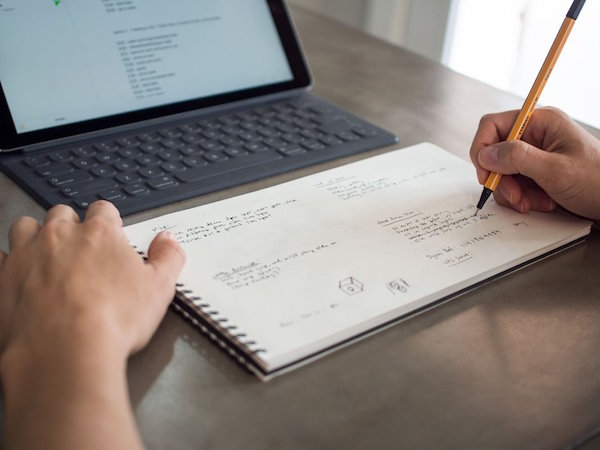
Created by Texas-based Studio Neat, known for a variety of innovative products, from wooden charging docks to cocktail-making tools to video-related apps, Panobook began life as a Kickstarter and quickly gathered community support.
It’s easy to understand why. Depending on the width of your desk, you may or may not have space to the left or right of your body. But your monitor is generally straight in front of you, and so is your keyboard, so unless you have an L-shaped desk, the real estate in front of you is pretty tightly packed.
If you want to take notes, maybe you can scroll (I mean, slide) your body to the left or right, or you may have to swivel in your seat to use the left side of the desk (or the right side, if you’re left-handed) to take notes. Unless your arms are long (and your eyesight so pristine that your monitor is very far away), there’s just not that much writing space in front of you. (And I’m pretty sure you don’t want a notebook poking into your tummy.)
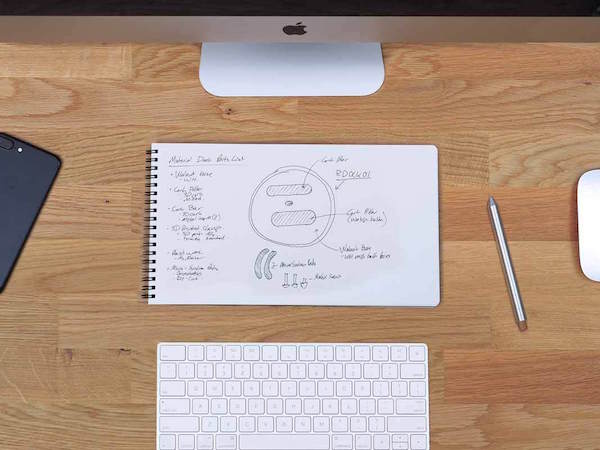
Panobook was created to solve this problem of limited space. The panoramic format, measuring 160 mm x 288 mm (6.53″ x 11.34″) is designed to sit squarely in front of, or if you prefer, behind, your keyboard. (Turned vertically, of course, it can sit to the left or right, if you have that much space. But then you’d probably be using a traditional notebook or legal pad, right?)
Panobook is made of high-quality (Finch Fine Soft White Ultra Smooth 70 lb text-quality) paper and designed to perform with a variety of writing instruments and inks without causing bleed-through or smudging. Both the front and back of Panobook are rigid, made of Neenah LaCrema 617 Charcoal-colored 50 pt black chipboard. It’s all bound with sturdy black Wire-O (12.7 mm (0.5″) diameter), so Panobook will sit flat when opened on your desk. (For some of us, this is a huge deal!)

Each notebook contains 50 sheets (100 pages). Instead of being lined or blank, Panobook has a subtle dot pattern with grid spacing at 5 mm (0.20″). And there’s a quirky little twist. There are guide markers on each page that make it easy to quickly draw three rectangles on the page, sized ideally for web designers doing smartphone user interface design or creative types for doing storyboarding. There are also edge guides to divide each page and provide cues for layout. They’re subtle, so if you don’t need them, you might not even notice them.
So what do you do when you finish the notebook? Panobook is designed to let you archive your creations and comes with a slip case in a French Paper Kraft-Tone Standard White 100 lb Cover (for people who know about such things). Write on the spines to catalog your notebooks and keep your collection together on a shelf.
See the Panobook in action:
You can buy Panobook directly from Studio Neat for $20/notebook for one or two; they’re discounted to $19/notebook when you purchase three or more.
TRIANGLE NOTEBOOK
When I first saw the Triangle Notebook last summer, it seemed vaguely familiar. Back in 2012, there were quite a few posts on the design blogs about this product and it was selling at the Metropolitan Museum of Art shop. However, by the time I planned to write about it, the Triangle Notebook had already sold out and been withdrawn from the marketplace. Now it’s back in an improved form.
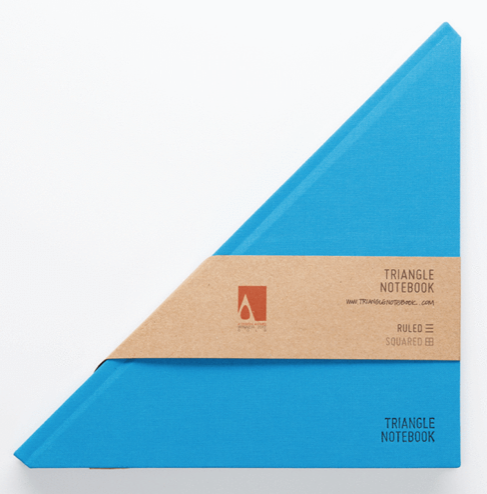
The Triangle Notebooks (both the original and improved versions) were created by Tan Mavitan, a creator based in Istanbul, Turkey and best known for his sculptures. As you can imagine, artists need someplace to collect designs and thoughts, so who better to imagine innovatively designed notebooks?
The Triangle Notebook appears to be just that: When closed, it’s a triangle. Flipped open, the notebook is square. The hard front and back covers and spine are encased in fabric, and the 160 interior (90 gr acid-free paper) sheets are narrowly ruled.
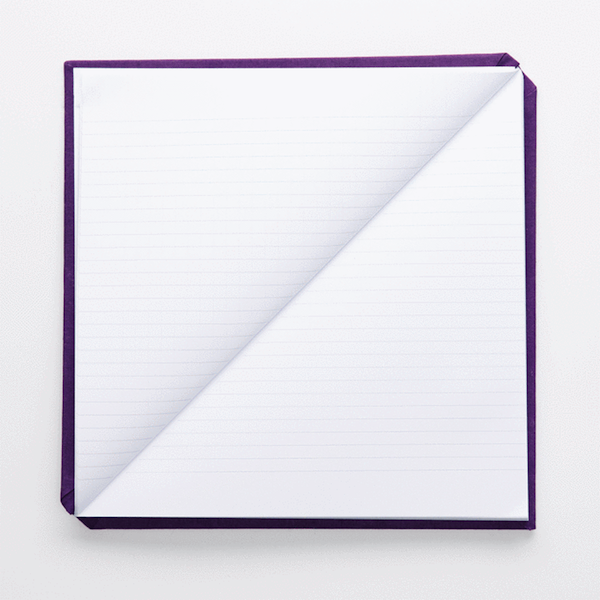
The Triangle Notebook comes in 13 solid colors, including Black, (light) Blue, Dark Green, “Green” (which looks more like chartreuse), Navy Blue, Pink, Purple, Red, Yellow, Dark Amber, Ghost White, and Mustard. There are also three Special Edition Triangle Notebooks: Triangle Thoughts (white with black avante garde style, and Yachtsman Blue (pictured below) and Yachtsman Red. All notebooks are 21 cm x 21 cm (8.26″ x 8.26″).

Personally, I find $33 to be a steep price, even for an admittedly lovely hardcover notebook, but my larger concern is that the pages may not lay flat when the notebook is open. Of course, at about 8 1/4″ square, you could place a small book weight in the center without obscuring too much of your content.
All versions of the Triangle Notebook are available from Amazon or from the Tan Mavitan Studio shop. The price in both venues is $33. The Studio often has discount codes listed at the top of the page; as of this writing, WELCOME2019 yields a 20% discount. However, there’s no shipping rate information on the site, and the notebooks do qualify for Amazon Prime two-day shipping, so check both options to see what works best for you.
SIDEKICK NOTEBOOK
Remember what I was saying about real estate on your desk being at a premium? Panobook isn’t the only option for handling this problem creatively. The Sidekick Notebook appears to be a mostly normal (if narrow) portrait-oriented notebook with a bottom margin cut strangely on the diagonal.

When closed, the Sidekick Notebook measures 21.5 cm x 8.5 cm (8.46″ x 3.34″). But once it’s flipped open, the Sidekick is actually an L-shaped notebook designed to hug the corners of keyboards, iPads/tablets, mousepads, books, and other square-ish items.
Instead of a portrait or landscape orientation, the Sidekick delivers both options simultaneously
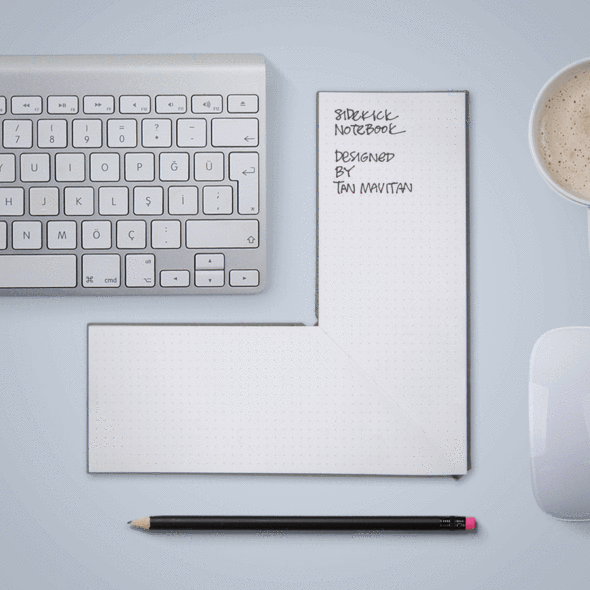
The Sidekick, which comes 160 sheets (of 90 gr acid-free paper) per notebook, has a hard fabric-encased cover and comes in four colors: Red, Black, Navy Blue, and Light Gray. The layout is dot- grid style.
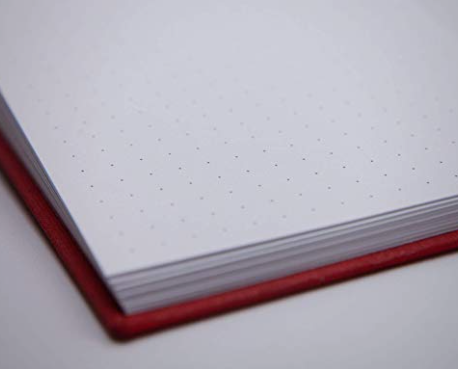
I suspect that the Sidekick won’t serve well for sketching large designs, but with both landscape and portrait writing areas, it’s good for taking notes and creating fiddly, small-detail designs.
The Sidekick is available for $24 per notebook from Amazon and from the Tan Mavitan Studio store, with the same discount and shipping caveats as noted above for the Triangle Notebook.
As always, the content you create and capture in your notebook is more important than the size, shape, color, or design. Sometimes, if a notebook is too spiffy (or expensive), we are reluctant to put anything but our “best” notions in them, which may mean procrastinating on doing anything at all.
If a unique design inspires you, embrace an unusual landscape or angle. Just give yourself permission to create first, and judge your work later.


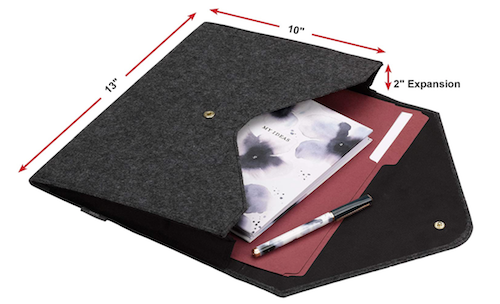

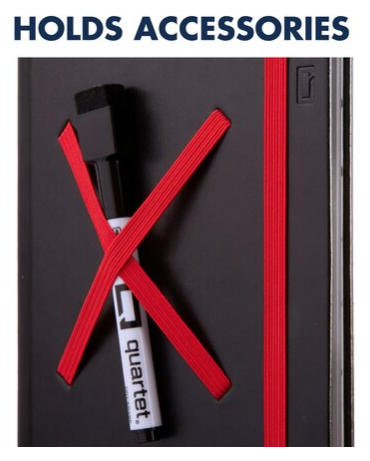

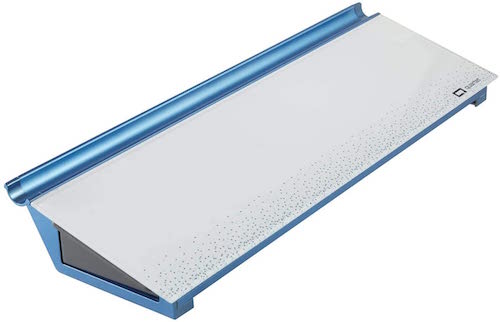
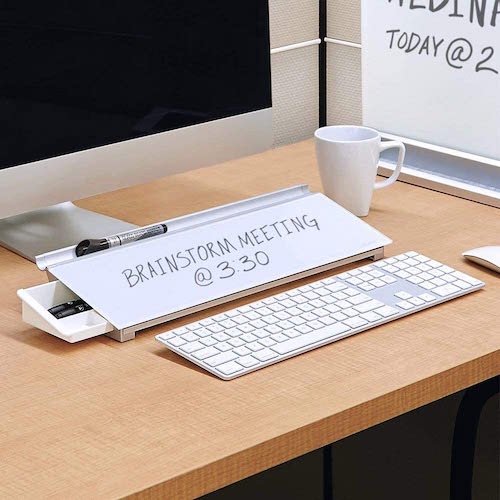
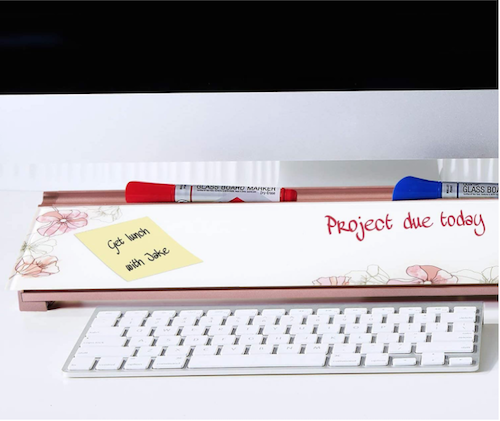

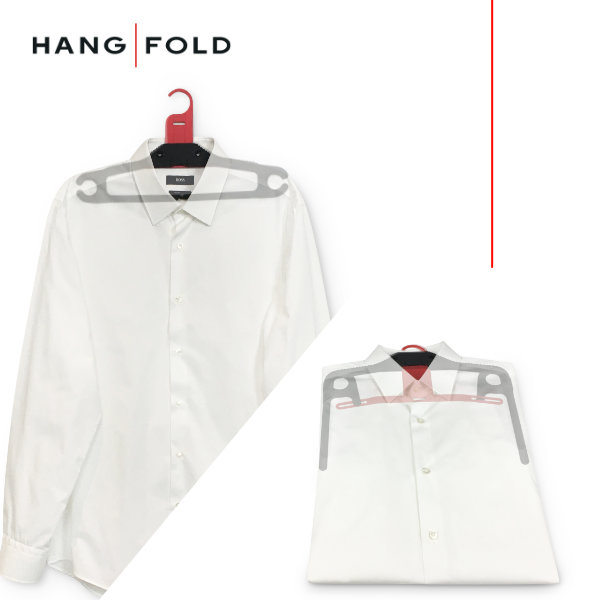
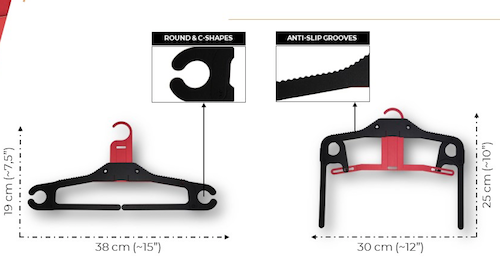

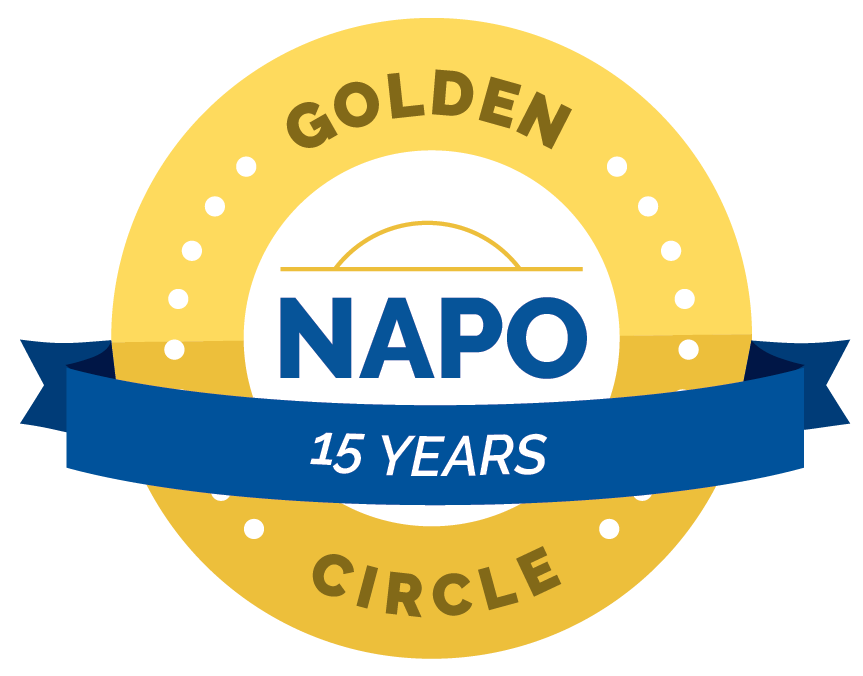


Follow Me